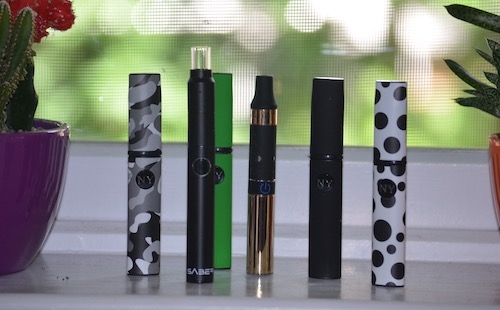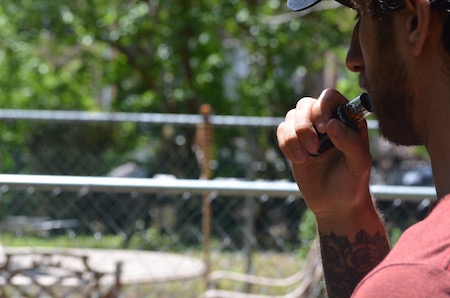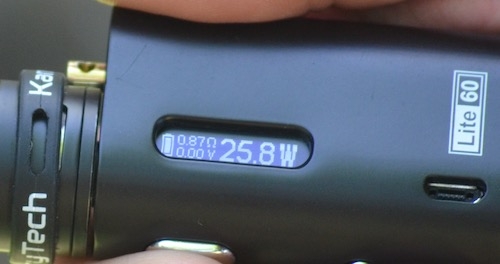What is the Best Temperature for My Vaporizer
Learn the best temperature to use for vaping dry herbs, wax and oils. Each product and vape pen is different so the perfect vapor temperature will vary. Read further as we break down this vape question with answers.
Vape Temperatures Introduction
Vaporizers come in all shapes and sizes, from massive desktop vapes to pencil-thin vape pens. They are all designed to heat a chamber, usually be means of coils or atomizers. The chamber could heat using convection or combustion, and could be designed to vaporize dry herbs, waxes, oils or liquids. Regardless of the vaporizer, we all want to get the best hit possible. The key factor for getting a solid hit out of any vape is getting the vape temperature right. After reading this article, you should be getting solid, smooth hits with maximum efficiency out of any vaporizer.

Dry Herb Vape Temperatures
We’ll start by looking at dry herb vapes because they’re the most popular. Regardless of size, all dry herb vaporizers come with some sort of temperature control. Some vaporizers only have a few temperature settings. However, more full-feature vapes like the E-CLIPSE can fine tune heat settings by a single degree. The most ideal temperature varies the most on dry herb vapes as many factors can affect it.-
First of all, the ideal temperature will vary based on the exact herbal material being used, but most users will want to vape dry herbs between 375°F and 430°F. Setting your vape around 375°F is better for the connoisseur. You’ll get better flavor but might not release all the important compounds in your herbs. The hotter you get, the more potent the vapor becomes, but it also can get harsher. At 455°F, your herbs will begin to burn so you should never go there, but the average convection vape won’t even go that high anyway.
In addition, the temperature of your vape should be adjusted based on the water content of your herbs (how dry or moist they are). Buds with more moisture will need a slightly higher temperature. The grind quality also will affect the ideal vape temperature. You should always have a fine grind when vaping dry herbs, but we get it, sometimes you leave the herb grinder at home and have to vape bigger chunks. While it’s not ideal, you can bump up the temperature up inside the heating chamber to help better penetrate those dense chunks.
Also, if you over-pack the vape pen, you may need to heat it up a bit hotter than usual. Ideally, the chamber should be packed full, but packed lightly to maximize the surface area of your dry herbs. If you over-pack and don’t seem to be getting solid hits, try heating it a bit more than usual to maximize vapor production.
Lastly, when using a new vape, you should always start out at the lowest setting and work your way up until it’s giving you nice, solid clouds but is still hitting smooth. If you’re getting super harsh hits, the temperature is too high and the vapors are too hot. If you’re getting thin, wispy hits with barely any taste or visibility, the temperature may be too low. Remember, the best temperature in the heating chamber will vary up depending on exact conditions, so that is why it’s best to start low and work your way up to find that perfect vaping temperature. It’ll be easy to lock in the best setting on pens with only a few settings since you only have a few options, but connoisseur dry herb vaporizers like the E-CLIPSE will give you much more flexibility since you can adjust by as little as a single degree – so it may take a bit longer to super fine tune your perfect vaping preference.

Wax Vape Temperatures
Most wax pens don’t even have temperature settings. However, vapes like the SteamCloud EVOD vape pen have variable voltage settings which controls the amount of power flowing to the coil, ultimately controlling the temperature. With wax pens, heat potential is measured by the watt output of its heating element (ceramic dish or quartz rods). The higher the watt output, the higher the potential heat you’ll get. Quartz will usually heat faster and hotter than ceramic, but ceramic wax coils will retain heat longer.
The heat at which you vaporize wax really comes down to personal preference. While some users want massive clouds, others prefer a slow, tastier simmer. When using a wax pen, you should definitely be between 315°F and 650°F but an ideal wax vape temp is somewhere between 420°F and 550°F. This should be attainable on all wax pens. The average wax pen without heat settings will get hotter as you hit the pen, so just continue to heat the coil to get bigger and thicker rips. On the other hand, if you’re looking for smooth, flavorful hits, just give it a little time between hits so the coil does not get scorching hot – this will help maintain a lower temperature within the wax coil.
If your wax pen has variable settings, set it to a higher temperature, volt or wattage setting for bigger hits and switch it to a lower voltage for smooth, tasty hits. Of course, if you are continuously ripping the pen for a while, naturally the temperature will be hot, so even with a variable voltage pen you may want to chill out for half a minute to let the coil cool slightly.
The Saber Vape also has a rare auto heat feature that does a great job of heating any wax to a consistent, baking temperature for a smooth and flavorful vapor.

Oil Vape Temperatures
Similar to wax vapes, many oil vaporizers won’t have temperature settings but will heat up as you use them or press the power button. And also like wax pens, the best temperature is up to personal preference; a hotter chamber will result in thicker, harsher vapor and a cooler chamber will result in thinner but often more flavorful vapor. Generally, you want to vape oils between 340°F and 445°F. If you go over 455°F, you risk burning the oil. Similar to vaping dry herbs and waxes, the lower end of this spectrum results in better flavor and the high end will make sure you release the full-potential of the compounds found in your herbs.
If you’re using 510 oil cartridges, you’ll probably be using a simple pen shaped vape battery, or perhaps you have moved on the newer styles like the SteamCloud Mini for Oil Cartridges. From those to the average EGO 510 thread vape battery, these pens can get hot but it’s often hard to get massive rips from them, and often temperature control is not available. However, if you want to step up your game and get the most out of your oil cartridges, you should consider a box mod. These are often ideal for vaping a variety of dry herbs, waxes and oils. We’ll get into more detail on box mods next.

Box Mod Temperatures
Box mods are essentially a high end vape battery that can be used with herb, wax or oil. Finding the ideal temperature for your box mod really depends on the 510 atomizer attached. Rather than setting a temperature, the output is usually set in watts and reflects how much energy is being sent to the atomizer aka coil.
Box mods like the SteamCloud, Kangertech, Smok or whatever else, have adjustable watt output. This should be adjusted based on your atomizer. Again, regardless of your atomizer, it’s best to start lower and work your way up until you get the perfect vapor, whether that’s a hot, thick vapor or a thin, cooler vapor loaded with flavor. Keep in mind that dry herb atomizers can handle a much lower power output than wax or oil atomizers. E-liquid atomizers, probably the most common 510 atomizer used on box mods, will provide the highest watt output of any atomizer. This results in massive, thick clouds bigger than you could get with any vape pen. Lastly, along with adjust for the atomizer attached, the temperature your box mod vapes at should be set based on the material. So as stated earlier, dry herb should be vaped between 375°F and 430°F, wax between 420°F and 550°F, and oil between 340°F and 445°F.

How to choose the right temperature
Choosing the right temperature is different for each vaporizer and coil attachments. It depends highly on whether you’re vaping dry herbs, waxes, oils, or liquids. Additionally, lower temperatures will result in thinner, smoother vapor whereas higher temperatures will give off massive, thick rips but will get harsh if too hot. It’s best to test out each vape on different temperatures as conditions vary based on chamber type, wattage, and substance used. Also, remember to start out on the lowest setting (or at least the lowest recommended above) and work your way up until you find the ideal vape temperature for you. This will be easy to lock in with vapes that have a few temperature settings but slightly more difficult for those that adjust to the degree or watt. Lastly, remember those vapes with no temperature setting will continue to heat with longer, stronger pulls so it’ll take some practice to dial them in. However, once you get used to how quickly it heats, you’ll soon learn how to get the best hits.
High Temperature vs Low Temperature
As stated above, the ideal temperature for each vape varies based on many factors and comes down to personal preference. To make things easier, here’s a look at the main difference between vaping at a low temp vs a high temp:
High Temperature Vaping
- Results in bigger, thicker vapor
- Harsher than lower temperatures
- Best for waxes, oils and liquids
- Can release more herbal trichomes (the tiny hairs holding the plants most important molecules for flavor, aroma, and effect)
- Can burn if you get too hot
Low Temperature Vaping
- Thinner, smoother vapor
- Cooler vapor which means it’s easier on your lungs
- Most important for dry herbs but can also be less harsh when using waxes, oils and liquids
- Lower temps may not release the full potential of your dry herbs, waxes, oils or liquids
- Can get exceptional flavor and aromas using a lower temperature (but not too low)
- Won’t release all the important herbal compounds if you’re too low (typically below 340°F)
We hope that you’re now fully informed on how temperature can affect your vaping experience and you’ve found out how to get the perfect vapor out of whatever pen, box mod or desktop vape you’re using. Happy vaping!
Related Blog Posts
How to Use a Temperature Control Vape Pen
What is the Most Ideal Vape Temperature
Blog Categories
- Home
- Industry News
- Vaporizer Reviews
- Dry Herb Vape Tutorials & FAQ
- Wax Pen Vape Tutorials & FAQ
- Oil Vape Pen Tutorials & FAQ
- Vaping Guides & Information
- Dabbing FAQ & Guides
- Smoking Pipe Tutorials
- NY Vape Shop Listicles
- Vape Pen Comparisons
- Vape Shop How To Articles
- Vape Shop Buyers Guide
- Vape Pen Basics
- Herb Grinder Reviews
- Dry Herb Vaporizer Reviews
- Oil Vape Pen Reviews
- Wax Pen Reviews
- Box Mod Vape Reviews